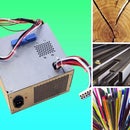Introduction: Choosing Greener Plastics
Interested in choosing greener plastics and avoiding toxic crap? Whether you're making fun geekadelic stuff or hardcore Eco-geek stuff, how do you choose healthy sustainable plastics?
Step 1: Think — Do You Really Need Plastic? or Would Wood or Metal Work?
Plastic is an amazingly useful material, but it's often less eco-friendly than wood (which is natural, usually non-toxic, sequesters CO2, is compostable, and often reusable) or metal (which is easier to recycle, easier to buy recycled, and usually more durable). So do you really need plastic?
Thin-sliced wood can be used for most things you'd do with plastic sheet, and laser-cuts very well. However, it doesn't have the same physical properties (it's more brittle, not transparent, etc.)
Metals are much easier to recycle than plastics—you can even get money for it. It's especially hard to find recycling locations for the sort of plastics you're likely to buy for making stuff (acrylic, polycarbonate). Metals are also usually much stronger and more durable. They can be harder to work with than plastic in some ways (cutting, bending) but easier in other ways (gluing, welding).
Step 2: When You Go to Your Local Plastics Store, Raid the Scrap Bin!
If you're saving something from landfill, you can argue it's "ecologically free". Don't get too self-righteous about this, but it's a pretty good rule of thumb.
Also, pulling a material from the scrap bin doesn't reduce any bad health effects the material might have on you!

Step 3: Find Healthier & Greener Plastics, and Where to Buy Them.
Your local store might have good stuff. Any TAP plastics (if you're in the USA) will have plenty of acrylic, many hobbyist 3D printer makers sell PLA filament in spools for their printers, etc. Or you might be better off ordering online.
However, don't expect anyone in a plastics store (in person or online) to know jack about the health or sustainability of the plastics they sell. Most people don't. So here's what you need to know, below. The healthiest plastic you can use depends on what you're doing with it: Heat-forming? Eating or drinking out of it? Laser-cutting? 3D printing?

Step 4: If You're Melting or Burning...
If you're laser-cutting, FDM 3D-printing, or otherwise melting the plastic, you might be exposing yourself to burning plastic fumes. These fumes are basically always toxic, but some plastics aren't that big a deal, while others are truly nasty. Some melted or burned plastics release things like dioxins, hydrogen chloride, hydrogen bromide, formaldehyde, phosgene, particulates, and more. You won't drop dead from the tiny amounts you'd breathe while laser-cutting, unless you're doing things horribly wrong, but it's somewhat bad for you (and those around you) in the long run.
More toxic plastics are PVC, ABS, PC (polycarbonate), and PS (polystyrene). PVC is usually singled out as the worst. Less toxic plastics are polypropylene (PP), polyethylene (PE, PET, LDPE, HPDE, and UHMW, and Mylar), acrylic (also known as Plexiglass, Lucite, or PMMA), silicone, and PLA (a bio-plastic). PLA is usually seen as the best, along with some other bio-plastics.

(Above image) Adapted/ cropped from "GIANT Laser Cut Milwaukee Map!", Author: Kevin B 3, Source link, Licensed under Creative Commons Attribution 2.0 Generic: CC BY 2.0.
Step 5: If You're Casting With It...
If you're making a mold to cast things in, silicone is great: besides its low toxicity, it's flexible enough that you can mold complex shapes with undercuts and still pull the mold off afterwards. It's also easy to buy at most plastics stores.
If you're casting things IN clear plastic, acrylic is the default at most plastics stores. This is a slightly different version of acrylic than the sheets you'd laser-cut or heat-form, but both are fairly low-risk. When you mix up the two resins, you'll be exposing yourself to some bad fumes even though you're not melting anything, but they're less toxic fumes than most epoxies give off.

Step 6: If You're Eating or Drinking Out of It...
If you're eating or drinking out of the thing you'll make, definitely choose polyethylene, polypropylene, acrylic, silicone, or PLA. Those are what commercial food and drink packaging is made out of, from milk jugs (LDPE) to 2-liter bottles (PET) to heat-resistant spatulas (silicone) to compostable party cups (PLA). Here's a 3D-printed wine glass made of PLA!

Step 7: Plan for Recycling/ Biodegrading.
When choosing the right plastic for your project, you're not just worried about toxicity; you also need to plan for recycling or biodegrading. This is especially important if the things you're making will only be used for a short time before getting thrown away. There're basically just two easy choices here: polyethylene and PLA.
Polyethylene is by far the most-recycled plastic everywhere. Recycling code #1 is PET, #2 is HDPE, #4 is LDPE. While polypropylene is another good plastic environmentally, almost no city recycling systems take it, so if you want to use it, make sure you've got a place for it to go at the end of its life. And most of the nastier plastics (ABS, PVC, polycarbonate, polystyrene) don't get taken by municipal recyclers either.
PLA and other compostable bio-plastics can be a good option, but they don't break down in any old backyard compost bin, they need the higher heat that municipal-scale compost facilities provide. If your city has a compost system like this, then great. Otherwise you'd be better off using polyethylene and recycling it.
Here's another chooser chart, combining recommendations from the Healthy Building Network and someacademicsources. You can also download a quality PDF of this chart below.

Attachments
Step 8: Check Your Plastic's Physical Properties.
Now you've got your list of greener plastics, but are they up for your job? It's not very eco-friendly to break and ruin your whole thing that you made. So make sure you choose a plastic with the physical properties you need.
For instance, PLA has a low melting point. So while it's fine for a wine glass, you'd be sad if you tried to use it for tea :(
Write down the properties you need: high temperature, strength, flexibility, abrasion resistance, electrical insulation, whatever your real deal-breakers are. Then check that your greener plastic meets your specs. If it doesn't, choose the next-best type of plastic. For instance, acrylic has great optical clarity and is easier to bond than polycarbonate, but it's more brittle and scratches more easily. Nylon, polypropylene, and polyethylene usually don't form as well as ABS, but have better fatigue resistance for joints and bushings.
There are tons of resources on the web for choosing plastics based on the physical properties you want—any web search will pull up plenty. Two trusted resources are Engineering Toolbox and MatWeb. Curbell Plastics also has a comprehensive yet readable selection guide.
Step 9: Working With Plastic
When you laser cut, 3D print, heat form, sand, or otherwise mess around with plastics, try to avoid breathing it in. Even the greener plastics here aren't good for you to breathe, they're just less bad for you, and anytime you have chemical unknowns, it's better safe than sorry. Things that seem fine now could mean cancer ten years later, so be smart and keep your air clean by using good ventilation, an air purifier, and/or wear a respirator.

I'm smiling in this picture, really.
For an air purifier or respirator, read the packaging to see what the filter is rated for. Choose one that's rated for organic chemicals and particulates. A simple home dust mask or bedroom air purifier doesn't cut it.

You may want to check out this fume extractor and these other air purifiers.
Once you've got your greener plastic and your safety gear, you're ready to go! Have fun making!
Step 10: Optional: Testing Your Setup
If you want to test the safety of your own setup, you could. It's not that difficult, but it takes a lot of effort and buying (or borrowing) special chemical sensors. Here's an Instructable where people measured one particular gas, hydrogen cyanide, and found their printers safe for it. However, this scientific study measured ultrafine particles, and found that 3D printing PLA was ok but ABS was not.
To do your own safety testing, you'll need to get a bunch of specialized sensors to measure the things you're concerned about: particulates, hydrogen cyanide, hydrogen chloride, volatile organic compounds, and other chemicals (the more you test, the more reassured you can be). It's not as much fun as making stuff, but it could lead to cleaner, healthier fabbing for you and others.














